Border War! Vermont vs. New Hampshire Skiing Part 8 – Mount Sunapee
—by Jay Flemma
Special to Slave to the Traffic Light Adventure Magazine—
[Editor’s Note: In a wonderful bit of synchronicity, this piece is published on Jay’s 16th anniversary of becoming a sports writer. Through the years, the Anniversary Article has always been a special occasion, and we smile broadly this morning knowing that charming Mount Sunapee, skiing jewel of New England, got the honor. And it also marks the first time a skiing piece was featured for an anniversary celebration.]
NEWBURY, NH – It was one of those winters when March came in like a lamb and went out like a church mouse. The previous year saw a snow-maggedon called Winter Storm Something-or-other bury New Hampshire in 18-24 inches in just one day. But exactly one year later we saw 50 degrees instead. The snow was just beginning to soften, enough to feel as though you were skiing through a sea of BBs, while Mount Sunapee beamed joyously back at a bluebird sky.
And that was good enough for me and for everyone else that day.
So shoot me, I loved Mount Sunapee! Yes, it hardly has any expert terrain at all. Yes, it’s small without a lot of fancy frills. And yes, the proximity to Boston (just 84 miles up I-93) means you have to hold back the acid reflex caused by being in Patriots country. (GO STEELERS!) But Mount Sunapee is a keeper for myriad other reasons, and its whole is far greater than the sum of its humble parts.
Sunapee is easy to get to, ergonomically designed, fosters an atmosphere of rowdy fun while being family-oriented at the same time, and has terrain every skier can handle. It’s Blue Square Heaven for sure, but we all need a place like that, whether to raise the kids, teach a newbie, or just have a quick, low impact escape. And the views of the lake from the summit are as good as you find in the east; a bluebird day puts the “Sun” in “Sunapee.”
So “so what?” that Mount Sunapee’s a milk run?! Easy peasy, Sunapee-zee: It’s a bumper sticker, it’s a refrigerator magnet, it’s a mantra. And for some, it’s a lifestyle.
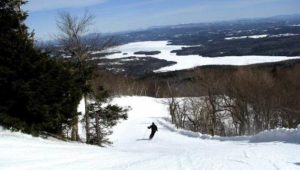
MEET THE MUELLERS
[Editor’s Note: Something a little different…in a first for this series, Jay tells the history of the resort through the eyes of someone intricately associated with its meteoric rise from humble beginnings to prominence, Tim Mueller, who along with his wife Diane owned and operated Mount Sunapee, as well as Vermont’s Okemo and Crested Butte in Colorado.]
Jay F: So did you get out of the biz at the right time, or what?
(LAUGHTER)
Tim M: Yeah, you could say that…
Jay F: Tell us about your first skiing memories.
Tim M: The first time I ever skied was in Winter Park, Colorado in 1963. I was 13, and my parents’ friends had a son my age. They came to visit Colorado and invited me go skiing with them at a place right across from slope-side, and it was a great time, I loved it. I also picked it up quickly, as most young kids would if you do enough athletics.
Jay F: Is that when you fell in love with it for life?
Tim: Oh yeah, that was it. Once I started, that was it. And then things really picked up when I started a family with Diane, and we bought Okemo in 1982.
Jay F: What are your first memories of Sunapee?
Tim M: Well it was back when Howard Dean was governor…
Jay F: Oh, do you mean Howard the Scream?
(LAUGHTER)
Tim M: (chuckling) Yes, that would be him. Well, New Hampshire and Vermont had the Governor’s Cup races at Sunapee that year. It was in the early ’90s, and I’d never skied at Sunapee, but Diane and I had owned Okemo for about ten years by then.
I was really impressed with it right away. It seemed a nice, small-to- medium sized area in an excellent location, with diverse terrain, lots of good intermediate level trails, an excellent beginner area, and a family atmosphere that was also fun. And it was owned by the state, which was important because I knew that they had discussions about privatizing their ski businesses. So I put it in the back of my mind to keep an eye on it.
Jay F: Now that’s a perfect segue into my next question: Let’s take a moment to summarize the history of the mountain pre-your involvement.
Tim M: The state decided they would build a recreation site next to Lake Sunapee. So they bought the land the mountain sits on through eminent domain from the farmers, which was controversial, even now we talk about it…
Jay F: The lawyer in me is biting my tongue right now…
(LAUGHTER)
[Author’s Note: According to NewEnglandSkiHistory.com, following the wild success of the aerial tramway on Cannon Mountain in 1938, it was decided to attempt to develop a similar aerial tramway-served ski area at Sunapee. While the project made significant strides in 1940 and 1941, World War II interrupted development. The New Hampshire State Highway Department began clearing trails in July of 1948, and Governor Charles Dale was present for a grand opening of the facility on December 26, 1948. Unfortunately, little snow was present, resulting in scenic chairlift rides, but no skiing. Skiing likely did not get underway until early to mid-January.]
Tim M: So they opened in 1948 with one or two lifts, a couple trails, and a little base lodge. Like a lot of areas, it had its ups and downs, but the state did install snowmaking, they added and upgraded lifts, and they built another lodge. They modernized Sunapee as best they could with limited state funds.
[Author’s Note: Sunapee expanded several times in its history pre-Mueller ownership, first in 1953 when the upper half of the Sun Bowl debuted, and again in 1954-55 with the addition of a T-Bar. Later, while Cannon Mountain received state funds for snowmaking expansion, a double chairlift, and a new tramway in the 1970s, Sunapee retained its existing lift infrastructure and continued without snowmaking.”]
Tim M (cont’d): Through the ’80s, they did okay, but there was also always talk of them going private. The state also owned Cannon, and neither area really made a lot of money. Finally, in the mid 90s, they passed a resolution directing the Department of Resources and Economic Development (DRED we call in New Hampshire) to put it out for lease bids by a private entity. There were five or six RFPs, and Diane and I won the bid. That was in 1998.
Jay F: Why buy Sunapee as opposed to other resorts?
Tim M: We weren’t in the market necessarily at the time. But Sunapee was close by, and it didn’t require a lot of initial capital because it’s a lease bid, not a purchase, so it didn’t require any money up front – just pay the lease payment (a fixed amount – $350,000/year, increased by the consumer price index every year), plus a percentage of revenue. It was zero down, but we also had to have a detailed development plan with improvements we wanted to make, and how we wanted to operate. The state really did their due diligence!
[Author’s Note: The Muellers leapt into action as soon as the ink was dry on the lease agreement. They invested $14 million over the next half decade, and improvements began immediately. Snowmaking was upgraded, two quad chairlifts were installed, including the area’s first high speed detachable quad, and a new lodge was built adjacent to its base. With further lift updates and a re-imagining of the beginner area, by 2000-2001 visits to Mt. Sunapee had more than doubled. The Muellers sold Mount Sunapee to Vail Resorts in 2018.]
Jay F: How did you grow your personal and family wealth to the point that you were able to afford purchasing and operating a large ski operation?
Tim M: Diane and I were in the resort business in the Virgin Islands through Diane’s family. We met in high school and dated throughout college. I went to Franklin and Marshall in PA and she went to a small women’s college in Pittsburgh called Chatham. We came back to the U.S. in 1982 when we purchased Okemo. Now Okemo is large physically, but they were also on the verge of bankruptcy. So it didn’t take a lot of money comparatively, but it did take almost all of what we saved up developing the Virgin Islands properties as well as a mortgage on our Vermont house.
Jay F: Tell us about skiing at Sunapee. What’s the heart of the mountain?
Tim M: Probably Outer Ridge and Ridge. It’s an old N.E. trail winding around the mountain. Everyone likes that one, from experts to novices. As for the toughest run, I’d have to say Lynx, that’s the traditional race course.
Jay F: What are your favorite Sunapee traditions?
Tim M: I think the crazy cardboard sled race. That’s unique and gets a lot of enthusiastic folks coming out for it. The pond skimming is fun too.
Jay: What about the on-mountain tail-gaiting at the base of the mountain?
Tim: Oh! They call that area “The Beach!”
(LAUGHTER)
Tim: They do it in February and March on mostly sunny days. You can literally park right your car right there on the shallow flat slope, and people get there early and set up chairs and picnic tables and cook out, bring their own food and beverages and have a great time.
Jay: …and point and laugh at people when they crash and burn?
(LAUGHTER)
Tom: Oh yeah, they do that. They’ll even give a cheer for a really good one. And they party all day! Some people even get there the night before and leave a car there to reserve the spot for the next day They’ll have their spouse follow them in their other car and carpool home and then back the next morning to be first at the Beach.
JF: Why sell it?
Tim M: Pretty simple. Vail came to us and wanted to buy Okemo at first, but then decided to buy all three that we owned and made an offer we didn’t want to refuse.
Jay F: What’s next for you and Diane?
Tim M: We’re retired. We still have commercial and developer real estate in Crested Butte. And Diane is still involved in the Okemo Mountain School. And we’re still active in the golf and lake club in Steamboat.
Jay F: Which one?
Tim M: We developed and own Catamount Ranch and Golf Club in outside of Steamboat.
Jay F: Are you also spending more time with Diane and your kids?
Tim: Of course. More time to do that. We live on a lake, so the grandchildren come over and spend time with us. They love tubing.
Jay F: What did you think when you heard Jeffrey Epstein’s madam, Ghislaine Maxwell, was hiding out right next door to Sunapee?
(LAUGHTER)
Tim M: Well it didn’t surprise me she’d be hiding in New England. You can live a pretty quiet life without notoriety in New England.
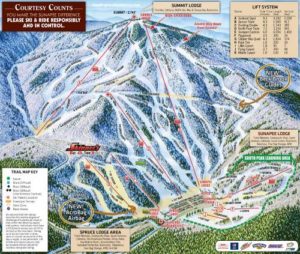
MOUNTAIN GAZETTEER
Money and TLC were all that Mount Sunapee needed, and the Muellers were not short of both. Make no mistake, the Muellers not only took Mount Sunapee to the next level with their advances in infrastructure, but their homespun charm and family wholesomeness became synonymous with Sunapee. You can still feel it to this day, and every patron who we talked to at Sunapee absolutely revered the Muellers. They were the polestar everyone was proud to follow. Only time will tell how much money and TLC Vail will provide in their turn, but with its proximity to Boston and enormous popularity and goodwill, Mount Sunapee’s a keeper.
It’s also a snap to get around. If you arrive early and hustle, you can ski the entire mountain in one day, (there are 68 trails on the map as we go to press), but it’s also large enough to spread out well and have a run to yourself virtually anywhere on the mountain, even on a busy day.
Lying in lat/lon 43 degrees, 18 minutes North, 72 degrees 4 minutes West, Mount Sunapee sports a 1,513 foot vertical drop from its 2,743 foot summit lodge to the 1,230 foot base lodge. Sunapee veterans all agree: open the day by taking the Sunapee Express to the summit, and then take Upper Cataract to the Sun Bowl Express and lap the east-facing – and therefore warmer in the morning – Sun Bowl to your heart’s content. Favorites include Wingding, the Skyway Ledges, and the Williamson Trail, the longest run at Sunapee.
Once you finish those, the front side off the summit offers staggeringly gorgeous views before tearing down Blastoff or Bonanza for a rip. Expert skiers looking for a challenge should stick to the glades or lap the North Peak Triple, although if it’s a race day, expect those runs -Â Lynx, Flying Goose, and Goosebumps->Eggbeater, the race course – to be super-slick. Of course there’s also the excellent novice area the Muellers so painstakingly stewarded, along with a good freestyle park and a sprinkling of thrilling glades interspersed between the Sun Bowl and the front side, a total of 230 skiable acres.
Now here’s, perhaps, the biggest bonus of all: no chair at Mount Sunapee takes longer than seven minutes to get to the top. Along with Cannon, it’s the fastest lift system in New Hampshire.
(As an aside, everybody in the region of Attitash who read that last paragraph just punched their computer screen. They sometimes go nowhere for seven minutes at a time at Attitash…)
And so the new logo of Sunapee is proving absolutely true: a bird soaring skyward in majestic flight with the sun on its wing. Now part of the Epic Pass, it’s under Vail’s envelope, so consult their website for the latest in Coronavirus updates.
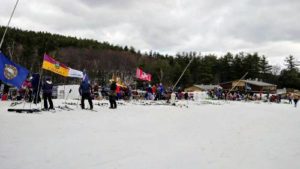
MOUNT SUNAPEE IS TERRIFIC, AND EPSTEIN DIDN’T KILL HIMSELF
This article bequeaths unto you two inalienable truths: Mount Sunapee rocks, and Epstein didn’t kill himself.
What does one have to do with the other? Let me explain: They busted Ghislaine Maxwell near Mount Sunapee. That’s right…Jeffrey Epstein’s alleged procurer/madam.
It was an eagle-eyed New Hampshire real estate agent who caught on that “retiring journalist Janet Marshall” who had just bought a house in nearby Bradford was really – Holy guacamole! – Ghislaine Maxwell! As in Epstein didn’t kill himself Ghislaine Maxwell! She had bought a secluded house less than eight miles from Mount Sunapee and had someone else doing all her shopping for her. What was that Tim Mueller just said about living under the radar in New England?
Still, surely that’s slumming it for her. If a hi-falootin’ British socialite on the lam for international crimes was going to get busted near a ski area, shouldn’t any self-respecting one have gotten caught at Waterville Valley instead? I mean you have to keep up with Kennedys somehow, no?
So with that as background for my trip, on one of my runs, I got separated from my skiing buddy – one of us zigged at the fork, one of us zagged – and I took the next chair to the summit with three young women. The one next to me, a pretty brunette with a white suit and pink and purple trim, had a little sticker on one ski that read “V. Epstein.” Puckish as ever, I pointed at it, smiled, and said, “You know, Epstein didn’t kill himself…”
“I HATE MY LAST NAME!!!” she burst out in what we lawyers call in the parlance an “excited utterance,” while her friends howled with laughter.
“We tell her that all the time!” one friend roared gleefully, snorting in between breaths. “Wait until I tell her husband!”
“It’s my husband’s fault! It’s his last name,” fumed Mrs. Epstein in response. “And don’t you dare say s%#t!”
It just goes to show, don’t mess with New Hampshire.
Quality of Snow/Grooming – 9.25
Variety of Terrain – 8.75
Lifts – 9.5
Snow coverage – 9.5
Natural Setting – 9.5
Kid/Family Friendly – 9.5
Character – 9.25
Challenge – 9.0
Dining on Mountain/Base Lodge – 7.5
Overall – 9.00
[Editor’s Note: This is the eighth article in our series analyzing the battle between Vermont and New Hampshire ski resorts. As the series progresses, here are the places we’ll visit:
For New Hampshire: Attitash, The Balsams, Bretton Woods, Cannon, Cranmore, Gunstock, Loon, Sunapee, Waterville Valley, Wildcat
For Vermont: Jay Peak, Killington, Mad River Glen, Magic Mountain, Mt. Snow, Okemo, Smuggler’s Notch, Stowe, Stratton, Sugarbush/Sugarbush North]
Other articles in this series:
PART 1 – WATERVILLE VALLEY
PART 2 – MAGIC MOUNTAIN
PART 3 – SMUGGLERS’ NOTCH
PART 4 – ATTITASH
PART 5 – MOUNT SNOW
PART 6 – CANNON MOUNTAIN
PART 7 – STRATTON MOUNTAIN
PART 9 – LOON MOUNTAIN
LAKE SUNAPEE COUNTRY CLUB
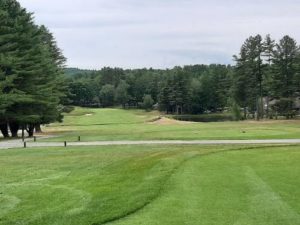
We played Lake Sunapee Country Club for the least scientific of reasons: It was the closest golf course to the ski resort.
Boy, did we ever hit the jackpot.
It was interesting to discover that Lake Sunapee Country Club is rated the top golf course in New Hampshire by several respectable publications, both print and on-line. Mind you – “Come on Eileen” was a number one hit in American popular music, so we take rankings with a grain of salt; they are meant to be examined, not just parroted. Still, a consensus number one in any state is a strong starting point.
Our interest grew to intrigue when we learned Donald Ross, one of the godfathers of golf course architecture in America, designed the golf course in 1928-29. And this wasn’t just some course where Ross breezed in for a few days, made some offhand observations, and then never returned. Instead, Lake Sunapee is one of only a handful – out of the close to 500 courses attributed to Ross – one of a select, cherished few where Ross chose the site for the golf course, designed it himself, and then oversaw course construction through to completion.
Better still our intrigue grew to excitement when learned not only that Ross’s original design was almost completely intact – all but untouched by intervening hands for 100 years – but that regional golf design star Ron Forse had just completed a sparkling restoration that has the golf design world buzzing with electricity. Lake Sunapee is now – as they say in the music industry – number one with a bullet, a rising star.
THE MANY SIDES OF ROSS
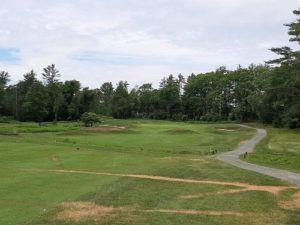
When we talk of his greatest designs, Ross is best known for his fire-breathers. Pinehurst No. 2…Seminole…Oakland Hills: miss the green at any of those, and you’re either in a monstrous bunker set well beneath the green, thirty yards back down the fairway after failing to carry the false front, or in a greenside swale facing ferocious contours that will shed your ball away from the hole. Likewise, even many of Ross’s smaller private clubs are steel-tough tests of precision, (Aronimink, Mountain Ridge, and Irondequoit, for example).
But Lake Sunapee is a softer side of Ross; gone is the white-knuckle terror on every approach shot. At Lake Sunapee, there is a right side to miss and a wrong side, much like Shenacossett, Ross’s Connecticut public masterpiece or Teugega, in Ross’s long-time home of Rome, New York. Since many greens feature open routes, often “the miss” is short, so bogey golfers can tack their way around carefully and cleverly. Finally, bunkers and other hazards are turned perpendicular to line of play, so there are strategic angles to consider off every tee box. At Lake Sunapee, it’s the intelligent golfer, not the longest who can outsmart Ross, not overpower him.
Lake Sunapee doesn’t need the sword thrusts of Seminole or Oakland Hills. Instead, much like Ross’s New Jersey masterpiece Plainfield Country Club, Lake Sunapee sits right in front of you…and confounds. You tend to bleed to death more slowly, incision by incision. You can’t help but laugh, because anything that went sideways on your scorecard was all…your…fault.
It’s the fairest Ross I’ve ever played.
“The founders of the Lake Sunapee approached Ross immediately after he finished his work at nearby Salem Country, actually going so far as to give Ross his choice of sites from among more than a half a dozen. Because of that, Ross had a heavy investment in Lake Sunapee and delivered in a big way,” explained Forse, whose touch-up work has helped turn Lake Sunapee from a local favorite to a course aficionados need on their bucket lists. He’s right: It was club President E.J. Poor who brought Ross to New Hampshire on a train, drove him around in a horse and buggy, and ultimately purchased a sheep ranch Ross selected for the golf course. Ross then brought in his own team, many of them fresh off the Salem gig, and together they made Lake Sunapee not so much a bookend to Salem, but a rousing encore.
“Best of all, in the entire history of the course, only once did the club ever make any changes to Ross’s design; Gene Sarazen changed the front left bunker of the eighth green. But when I first got there, about 75 years after Ross left, everything else was right where he put it,” Forse concluded. Sarazen, you’ll recall, won six majors, including the 1935 Masters, the second one ever contested. After retiring from professional golf, he summered at Lake Sunapee, and his descendents still live and play there to this day.
Finished in the mid 2000s, Forse’s work consisted of restoring where he could and updating where he had to by removing hundreds of non-native trees, expanding greens to their original size, restoring lost bunkers, and re-tying greens and tees close together, making the course easily walkable for everyone, not just strapping young college kids. The tree removal was particularly well-received as it opened up sweeping vistas of the mountain’s scenery.
The renovation polishes Ross’s design to a brilliant shine. Lake Sunapee’s smooth and ergonomic routing feels gentle and rolling, but maximizes the hilltops for green settings and tee boxes, putting a premium on distance control as well as accuracy. This can tend to fluster bomb and gauge golfers who look at the scorecard, see the short yardages, (only 6,700 from the tips and 6,360 from the blues), but forget that Lake Sunapee is a par-70 with only two par-5s, so it plays longer, especially the par-3s.
“‘The 12th is one of the hardest par-3s in all New England, 240 yards, all carry, uphill over a valley to a double-tiered green longitudinally bisected. The right is the upper tier. So you must be both long and accurate,” Forse explained. “Ross built similar greens at Manchester Country Club’s par-3 13th (New Hampshire) and at the 14th at Edgewood Country Club in Pittsburgh.”
Personally, Your Author’s favorites are the opener, a stern par-4 cascading down from the clubhouse and then ascending to a green guarded by a bunker set thirty yards in front of it, but appearing greenside, and the par-4 seventh, featuring “Mounds of Venus” in the fairway – a pair of towering mounds guarding either side of the green’s entrance, a classic Golden Age feature found on many great courses).
VESPER VELVET AND HER LAKE SUNAPEE SISTER
Of course you can’t talk about Lake Sunapee Country Club without at least mentioning Vesper Velvet.
Vesper Velvet, contrary to reports, is not a James Bond heroine. It is, instead, one of the finest old school strains of bent grass ever cross-bred for golf.
“Vesper Country Club in Massachusetts, [Author’s Note: halfway between Lake Sunapee and Boston], had a legendary head superintendent named Manny Francis, a Portuguese fellow who was there forever. He loved to tinker with cross-breeding turfgrasses, and he developed a strain of bent grass called Vesper Velvet that became the standard for many years at a lot of great New England courses,” noted Doug Homan, owner of Lake Sunapee, and grandson of Henry Homan, who operated the club from its inception. As a youngster, Doug Homan actually caddied at the club for members that were at Lake Sunapee when Ross designed the course, and he can recall almost seven decades of the club’s events.
“My grandfather, who knew Manny well, cultivated his own close-cousin cross-strain called Lake Sunapee Velvet, and it’s our entire playing surface, with the exception of our 10th green, which is actually Vesper Velvet.”
Lake Sunapee’s turf was so hardy and sustainable that, like its sister Vesper Velvet, it became a go-to, must-have option for clubs throughout the northeast. For many decades, other clubs would pay for sod to be delivered from Lake Sunapee to their club, and Lake Sunapee would sell off acres of extra sod, roll it up, and truck it to clubs all across the northeast who would then unroll it like a carpet. Immaculate Lake Sunapee Velvet was so in demand that it was even shipped to and used at Fenway Park and the White House lawn.
“We even sold sections of grass off the 16th fairway more than once during tough economic times,” Homan recalled.
Sadly, Vesper Velvet’s heyday has passed; it didn’t thrive in warm weather climates. Moreover, it tends to be soft and grabby as opposed to modern golf’s faster, firmer playing surfaces. On Velvet you can play darts with your irons, but you can’t putt from far off the green. Moreover, with thick, clingy rough making it seem more like Vesper Velcro, it does sometimes save your ball from perdition if you hit one off line, but it never rolls and tends to sink, yet another reason why Lake Sunapee plays much longer than the scorecard reads. Still, the greens are as smooth as glimmerglass, and the playing surface is immaculate.
NEW HAMPSHIRE’S PIN IN THE AMERICAN GOLF MAP
Charming, warm, and welcoming, Lake Sunapee is so eminently natural, you feel as though you’re either on one of the great English heathland courses, or perhaps somewhere in the Carolina low country. And it’s so timeless, you feel as though you’ve been transported back in time to the Golden Age of Golf. Lake Sunapee deserves to be considered among Ross’s best and most underrated private clubs, along with White Bear Yacht Club, Roaring Gap, and Minikhada, all first rate designs, tucked sleepily in out-of-the-way places.
New Hampshire’s pin in the American golf map, and an important historical marker in Donald Ross’s timeline, Lake Sunapee needs and deserves more attention. It may be off the beaten path for anyone not from Boston or Rhode Island, but it’s well worth the ride. For Bostonians, it’s just a quick 75 minute jaunt up I-93, the building of which greatly helped to swell Lake Sunapee’s membership.
And right on cue, it was a Bostonian whose words suddenly echoed like the report of a gunshot through the New Hampshire trees.
“That one! Right there!”
I wasn’t expecting such excitement from my Wingman golf and ski buddy, normally so stoic on and off the golf course. He was pointing at a condo just past the left side of the 10th tee box, one on the end, with a view up the fairway.
“I’m buying a condo, and I’ll use it for both golf and skiing,” he finished, beaming a satisfied smile. He’s been actively looking too, egged on by me.
I mean golfing and skiing: that’s what I call multi-purposing. I love the idea. Who wouldn’t?


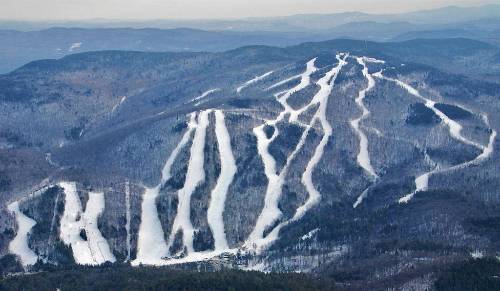
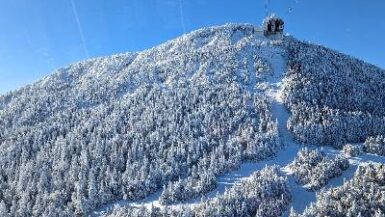

[…] PART 8 – MOUNT SUNAPEE […]
[…] PART 8Â MOUNT SUNAPEE […]
[…] PART 8 – MOUNT SUNAPEE […]
[…] PART 8 – MOUNT SUNAPEE […]
[…] PART 8 – MOUNT SUNAPEE […]